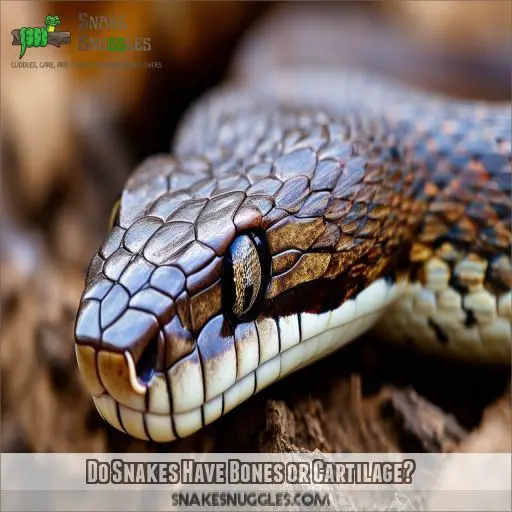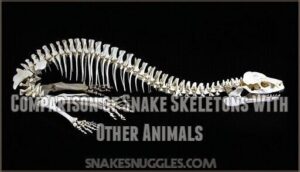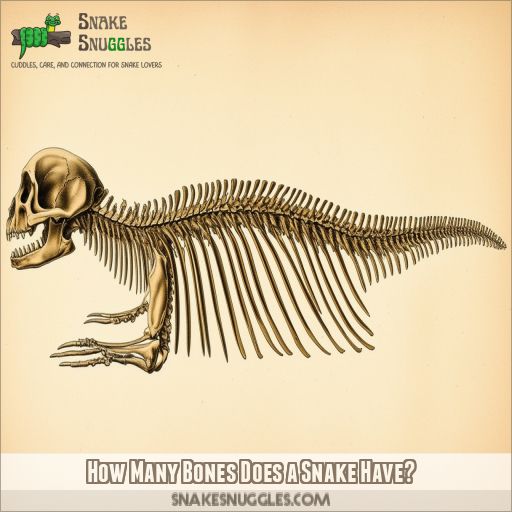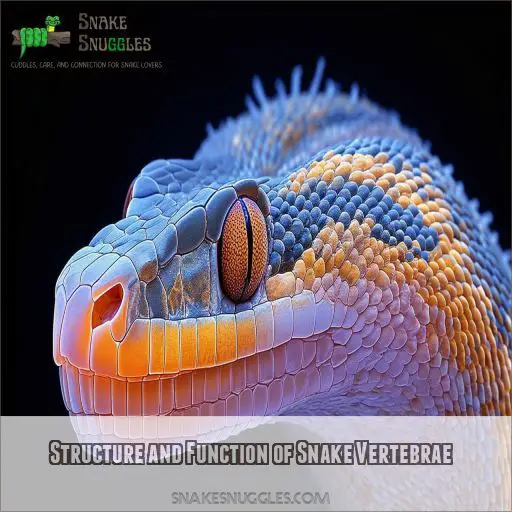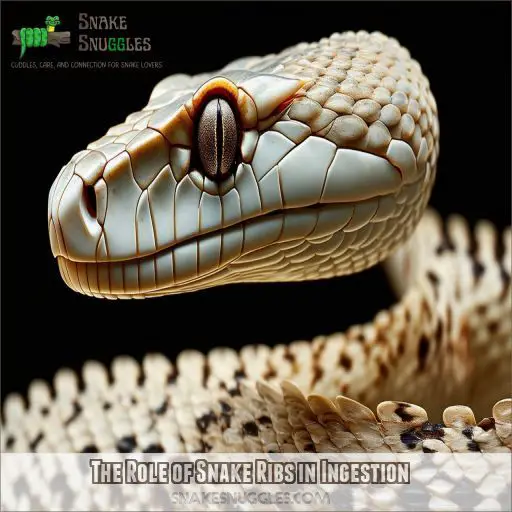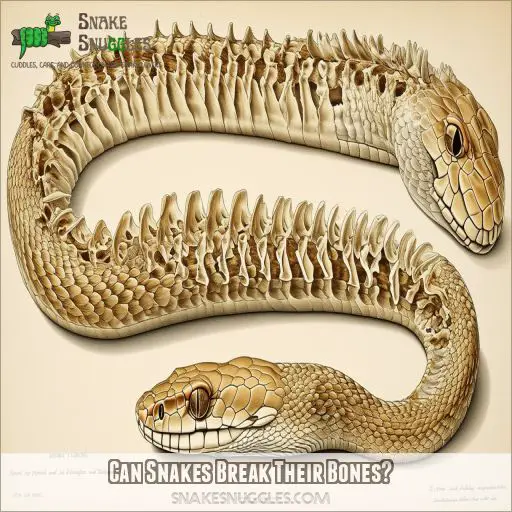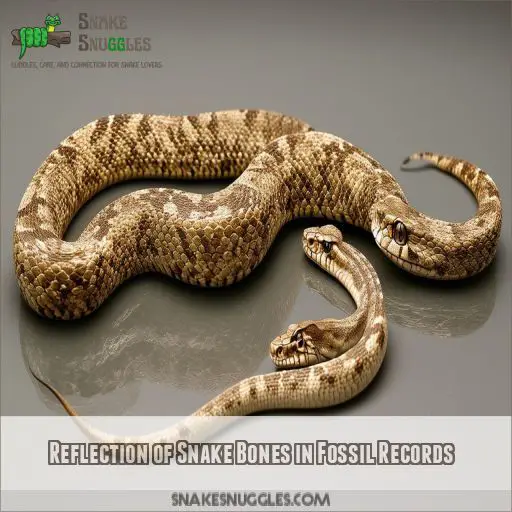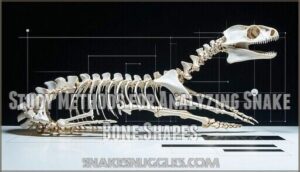This site is supported by our readers. We may earn a commission, at no cost to you, if you purchase through links.
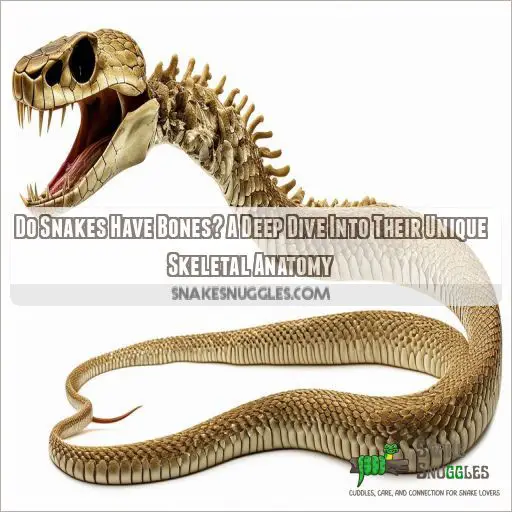
In this post, we will compare the anatomy of snake bones to that of other animals and learn about their specialized vertebrae and ribs. You will learn how many bones these snakes actually possess, the function of these bones while they swallow, and how they evolved over time.
It’s time for unwrapping the intriguing world of snake skeletons.
Table Of Contents
- Key Takeaways
- Do Snakes Have Bones or Cartilage?
- Comparison of Snake Skeletons With Other Animals
- How Many Bones Does a Snake Have?
- Structure and Function of Snake Vertebrae
- The Role of Snake Ribs in Ingestion
- Can Snakes Break Their Bones?
- Reflection of Snake Bones in Fossil Records
- Evolution of Snake Skeletons and Hox Genes
- The Influence of Hox Genes on Vertebrae in Snakes
- Study Methods for Analyzing Snake Bone Shapes
- Frequently Asked Questions (FAQs)
- Can snakes break their bones?
- How many ribs does a snake have?
- Do snakes leave bones behind?
- Do snakes have feelings?
- Can snakes dislocate their jaws to swallow prey?
- Do snakes have ears or ear bones?
- How do snake bones compare to human bones?
- Are snake bones lighter or heavier than other reptiles?
- Can snakes regrow or repair broken bones?
- Conclusion
Key Takeaways
- Slither me timbers! Snakes aren’t just noodles with scales – they’re packing a whopping 300+ bones in that sleek body. Talk about a spine-tingling revelation!
- These serpentine superstars have a jaw-dropping trick up their non-existent sleeves. Their loosely attached jawbones let them swallow prey bigger than their heads. It’s like nature’s version of "your eyes are bigger than your stomach," but in reverse!
- Snakes may have ditched the limbs, but they’ve kept the rib game strong. With 200-400 pairs of ribs, they’re basically walking (er, slithering) xylophone players. No wonder they can squeeze through tight spots!
- Hold onto your hats, fossil fans! Snake skeletons have been leaving their mark since ancient times. These bony breadcrumbs have helped scientists piece together the slithery saga of snake evolution. Who knew old bones could tell such a captivating tale?
Do Snakes Have Bones or Cartilage?
Yes, snakes have bones. Their skeleton system consists mainly of bony material, not cartilages.
The important bony elements include skull bones, vertebrae, and a long row of ribs. Comparatively speaking, as compared to cartilage, the bones in snakes, such as their vertebrae, are more dense and strong enough to hold vital organs and protect them.
Growth of bones and their repair in snakes take place according to the same biological rules that prevail in other vertebrates. Yet, certain features, like limb bones, typical in another creature, are lacking.
Their skeletal arrangements showcase a rather different strategy of structure.
Comparison of Snake Skeletons With Other Animals
Snake skeleton adaptations are unique, especially when you compare them to other animals. Unlike sharks, which have cartilage-based skeletons, or birds and pterosaurs with hollow bones for flight, snakes have a backbone made of numerous vertebrae and ribs.
Snakes lack limbs, but pythons and boas retain vestigial pelvic spurs. Their jawbones are loosely attached, unlike the rigid structure seen in elephants or birds. These differences highlight the diverse evolutionary paths in bone density and vertebrae shape among these fascinating creatures.
How Many Bones Does a Snake Have?
When comparing snake skeletons to other animals, you might wonder, "How many bones does a snake have?" Surprisingly, snakes can possess over 300 bones, showcasing their unique skeletal structure.
- Bone Flexibility: Their numerous vertebrae and ribs contribute to an incredibly flexible spine.
- Bone Growth: Snakes continually grow throughout their lives, including their bones.
- Bone Function: These bones provide support while enabling the snake to perform remarkable feats like swallowing prey larger than their heads.
Each bone plays a critical role in a snake’s survival.
Structure and Function of Snake Vertebrae
You may know that snakes have over 300-plus bones, but it’s in their vertebral structure where the real miracles lie.
In any snake, there are definite vertebral segments that show differences in shape and size of individual bones in different regions in the spine. This regional variation has its basis in the detailed interplay of Hox genes that act as evolutionary constraints on the skeletal development of the snake.
This unique design of vertebrae is involved in supporting snakes in slithering locomotion but also contributes to the creation of amazing bone density and biomechanics underlying flexible, sinuous movements.
The Role of Snake Ribs in Ingestion
Snake ribs are involved in ingestion. As a result of these specific mechanisms of expansion and elasticity of the ribs, the snake is able to consume prey much larger than its head diameter. Here are four key points:
- Rib Flexibility: The lack of a breastbone makes way for the expansion of the ribs.
- Expansion Mechanism: Unjoined ribs accommodate expansion to swallow large prey.
- Defensive Use: Some snakes modify rib structures for the purpose of self-defense.
- Ingestion Efficiency: Flexible ribs will push the prey down to the digestive tract.
Can Snakes Break Their Bones?
Snake ribs form an integral part of their specialized ingested food process that requires them to expand.
On the contrary to the fact that they have flexible bones, a snake can break their bones. Things like bone density and the growth pattern contribute to their overall flexibility of bones.
When a snake breaks its bones, including the rib bones or even vestigial leg bones in pythons, they do have some capacity for repair. It’s in this way that bone composition and adaptive growth patterns in snakes facilitate the repairing of fractures, so they could resume their predatory lifestyle with some degree of effectiveness.
Reflection of Snake Bones in Fossil Records
Fossil evidence holds captivating information about the evolutionary origins of snakes. Ancient snake fossils show similar anatomy to modern-day snakes, displaying remnants of vertebrae, ribs, and teeth. Comparisons of genes with other reptiles have helped track their phylogenetic relationships. Notable finds include spongy bone structures and remnants of venom systems.
Although different from pterosaurs in that there’s no development of shoulder blades, preserved fossils point toward the unique skeletal adaptations of snakes. These records are invaluable for understanding the entire evolutionary journey that started with ancient reptiles and resulted in the serpents we know today.
Evolution of Snake Skeletons and Hox Genes
It would be learned from the skeleton of snakes that the loss of Hox genes wasn’t instrumental in their evolutionary career. Vertebral regionalization in the case of snakes is achieved through differential expression of Hox genes. Curiously, it would also seem that snakes retain their vertebral regions as their lizard ancestors and unique morphological change.
Comparisons with fossils show how the evolutionary trajectory of snakes diverged from other vertebrates. It’s by applying the tools of morphological analysis on bones that scientists have come to learn exactly how these genes have indelibly stamped the course of snake evolution and understand their intricate skeletal structure.
The Influence of Hox Genes on Vertebrae in Snakes
Hox genes contribute to giving each vertebral region its identity.
This function of Hox genes needs necessarily to be conserved for maintaining vertebra shapes and positions that are distinct in the snakes.
During evolution, unlike some species, neither vertebral regions nor the functioning of Hox genes has been lost by snakes.
These genes, however, have etched out their evolutionary history and continued to readapt the complicated, marrow-filled bones with vestigial limbs that snakes display today.
Study Methods for Analyzing Snake Bone Shapes
To analyze snake bone shapes, researchers employ cutting-edge techniques like geometric morphometrics. This method allows them to quantify and compare complex skeletal structures.
They use regression-based analysis to determine how size and shape relate in vertebral structures. Maximum likelihood estimation helps pinpoint boundaries between vertebral segments.
These statistical analyses, combined with comparative anatomy, offer insights into snake evolution.
Studying bone shapes isn’t just about looking at fossils – it’s a high-tech field! By examining modern and ancient snake skeletons, scientists can piece together the puzzle of their unique anatomy.
Frequently Asked Questions (FAQs)
Can snakes break their bones?
While snakes aren’t as fragile as fine china, they can indeed suffer bone fractures. You’ll find that their flexible bodies aren’t invincible. Injuries can occur from falls, accidents, or rough handling, affecting their vertebrae, ribs, or skull bones.
How many ribs does a snake have?
You’ll find that snakes have a lot of ribs! Typically, they’ve got between 200 to 400 pairs, depending on the species. That’s way more than humans, who only have 12 pairs. Pretty impressive, right?
Do snakes leave bones behind?
In a blink, you’d miss their skeletal legacy! Snakes do leave bones behind when they die. Their vertebrae, ribs, and skull often remain as evidence of their existence, weathering over time but persisting in the environment.
Do snakes have feelings?
You might be surprised, but snakes do have feelings. They experience basic emotions like fear and aggression, and can even form bonds with their owners. However, their emotional range isn’t as complex as mammals or birds.
Can snakes dislocate their jaws to swallow prey?
You might’ve heard snakes can dislocate their jaws, but that’s not quite right. Their jaw bones aren’t fused, allowing them to stretch incredibly wide. This unique adaptation lets them swallow prey much larger than their heads.
Do snakes have ears or ear bones?
You’ll find that snakes don’t have external ears, but they do possess inner ear structures. They’ve got a bone called the columella that helps them detect vibrations through the ground, allowing them to "hear" in their own unique way.
How do snake bones compare to human bones?
While you have 206 bones, snakes possess over Their flexible backbone, made of numerous vertebrae, allows for incredible mobility. Snake bones are lighter and more elongated, with specialized jaw structures for swallowing large prey whole.
Are snake bones lighter or heavier than other reptiles?
You’ll find snake bones are generally lighter than those of other reptiles. Their elongated bodies require flexibility, so they’ve evolved a skeletal structure that’s less dense. This adaptation allows for their unique movement and feeding abilities.
Can snakes regrow or repair broken bones?
Ever wondered about a snake’s healing abilities? You’d be surprised! Snakes can indeed repair broken bones, though they can’t regrow them. Their bodies naturally mend fractures, but it’s a slow process that requires careful care and patience.
Conclusion
You now know that snakes do have bones, and their skeletons are a marvelous case of evolutionary adaptation. It ranges from vertebrae specialized for flexibility to flexible ribs; snake bones make their unique locomotion and feeding habits possible.
You learned how these reptiles evolved their distinctive skeletal structure and the role played by Hox genes in shaping their anatomy.
As you reflect back on the detailed world of snake skeletons, remember that these creatures are interesting not for being boneless tubes, but for being complex vertebrates with an amazing skeletal system modified in accord with their serpentine lifestyle.

